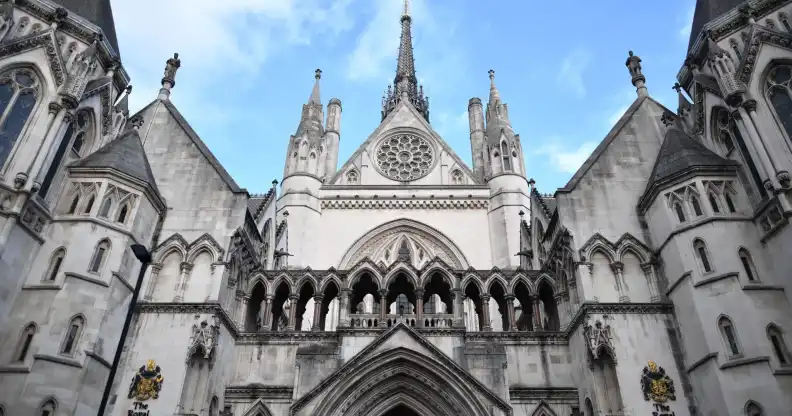Judge throws out LGB Alliance founder’s fight to ban trans women from women’s single-sex spaces

The Royal Courts of Justice where the High Court is located in London. (Getty/ BEN STANSALL/AFP)
The Royal Courts of Justice where the High Court is located in London. (Getty/ BEN STANSALL/AFP)
A judge has refused permission for a judicial review of the Equality and Human Rights Commission’s guidance on the Equality Act 2010.
Throwing out the attempted judicial review today, Mr Justice Henshaw, sitting in London’s High Court, said the case was “unarguable” and that its interpretation of the Equality Act 2010 is “wrong in law”.
The failed judicial review was sought by LGB Alliance co-founder Ann Sinnott, who crowdfunded more than £96,000 in legal fees. It concerned the EHRC’s guidance on the single-sex exemptions in the Equality Act 2010, which allow women’s single-sex spaces, like prisons or refuges, to only exclude trans women in certain, specific circumstances.
Sinnott argued that any women’s single-sex space with a trans woman becomes a mixed-sex space and therefore that the EHRC’s Code of Practice was unlawful, because it told service providers to treat trans women as women in most situations. Her argument was that trans women, with or without legal gender recognition, should always be excluded from women’s single-sex spaces.
Justice Henshaw had heard from Dan Squires QC, representing the EHRC, that “there is no evidence that on the basis of the Code of Practice someone has acted unlawfully”.
“It is not appropriate for a court to say that trans women should always be excluded,” Squires argued. “If there is a problem then it can be challenged and the court can judge if a service provider has done it wrong.”
While throwing out the attempted judicial review, Henshaw said: “The Code of Practice seeks to give concise and practicable advice.
“The claimant has shown no arguable reason to believe the Code has mislead or will mislead service providers about their responsibilities under the Act in order to place women or girls at risk.”
He added: “I recognise the concerns that women and girls and those who help to protect their interests have about the application of the gender reassignment provision in a particular context, however, it is in my view clear beyond argument that parliament has chosen to place transsexuals in a different position to persons of their birth sex.”
Trans and non-binary people are protected from discrimination under the Equality Act’s protected characteristic of gender reassignment, while women are protected by the protected characteristic of sex.
The EHRC’s case was that it “did not agree that it is always going to be justified as a matter of fact to exclude trans women”, Squires told the court.
“Our submission is if there are specific instances where trans inclusion is the practice, which is increasingly common, if that’s unlawful someone can bring a challenge to that and say we should not be allowing trans women, with or without a Gender Recognition Certificate, into this space, then the court should decide,” Squires said. “Not abstract and theoretical arguments about service providers.”
Representing Sinnott, Jeremy Hyam QC argued that the EHRC’s guidance for service providers on how to interpret the Equality Act in relation to single-sex spaces put women and girls at risk because trans women “are men”.
Hyam told the court that Sinnott’s case was about “protecting women, particularly vulnerable women like Muslim women”, and that the EHRC’s “incorrect guidance” meant that service providers were not confident in applying the single-sex exemptions and consequently were “undermining women’s rights which are enshrined in law”.
But Henshaw emphasised that trans men and women can already be excluded from single-sex services on a case-by-case basis under exemptions in the Equality Act “if it would be a proportionate way of achieving a legitimate aim”.

